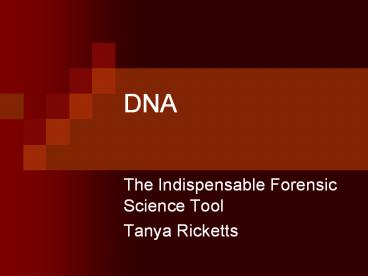DNA PowerPoint PPT Presentation
Title: DNA
1
DNA
- The Indispensable Forensic Science Tool
- Tanya Ricketts
2
- Deoxyribonucleic acid DNA
- 1985 discovery that portions of the DNA
structure of certain genes are as unique to each
individual as fingerprints - Alec Jeffreys and colleagues at Leicester
University named process for isolating and
reading DNA markers DNA fingerprinting
3
- Later called DNA profiling and DNA typing
- READ page 384 387 OJ Simpson
4
WHAT IS DNA?
- Inside each of 60 trillion cells in the human
body are strands of genetic material called
chromosomes - Along the ch. Are nearly 30,000 genes
- The gene is the fundamental unit of heredity. It
instructs the body cells to make proteins that
determine everything from hair color to
susceptibility to disease
5
- James Watson and Francis Crick 1950s
- Deduced the structure of DNA
- Controls the genetic traits of all living cells,
plants and animals - Four types of bases associated with DNA
- Adenine, cytosine, guanine, and thymine
6
- DNA is composed of two DNA stands coiled into a
double helix - A opposite T
- G opposite C
- Known as complementary base pairing
7
- DNA is a polymer
- Nucleotide unit of DNA consisting of one of
four bases attached to a phosphate-sugar group - Average human chromosome has DNA containing 100
million base pairs.
8
- All of the human chromosomes taken together
contain about 3 billion base pairs. From these
numbers, we can begin to appreciate the diversity
of DNA and hence the diversity of living organism
consisting of the alphabet - A,T,G,C
9
DNA at work
- Inheritable traits are controlled by DNA arise
out of its ability to direct the production of
complex molecules called proteins. - Proteins are made by linking a combination of
amino acids - 20 known amino acids
10
(No Transcript)
11
DNA REPLICATION
- DNA replication begins with the unwinding of the
DNA strands in the double helix. - Each strand is then exposed to a collection of
free nucleotides. - Letter by letter , the double helix is recreated
as the nucleotides are assembled in the proper
order, base pairing
12
- DNA polymerases are enzymes that assemble a new
DNA strand in the proper base sequence determined
by the original or parent DNA strand. - PCR polymerase chain reaction using DNA
polymerases to copy a DNA strand located outside
a living cell new lab technology
13
- Small quantities of DNA or broken pieces of DNA
found in crime-scene evidence can be copied with
the aid of a DNA polymerase - A DNA Thermal Cycler is used for the copying
process - Sample size no longer a limitation in
characterizing DNA recovered from csevi
14
- R/ship b/t base letters on a DNA strand and the
type of protein specified for manufacture by the
sequence of these letters is called the genetic
code
15
- Key to understanding DNA typing lies in the
knowledge that within the worlds population
numerous possibilities exists for the number of
times a particular sequence of base letters can
repeat itself on a DNA strand. Possibilities
become greater when one deals with two ch. Each
containing different lengths of repeat sequ.
16
- Its the length differences associated with DNA
strands or RFLPs(Restriction Fragment Length
Polymorphisms) that allow forensic scientists to
distinguish one person from another
17
- Once DNA molecules have been cut up by the
restriction enzyme, the resulting fragments must
be sorted out by electrophoresis DNA from
various sources, cut up by restriction enzymes,
is placed in an separate lanes on an
electrophoretic gel and subjected to an electric
field
18
- During this process, DNA fragments will migrate
across a gelcoated plate fragments are
chemically treated so that the strands separate
from each other - RFLP DNA typing- used in impeachment trial of
President Bill Clinton semen stained dress of
Ms. Lewinsky pg 372
19
SIGNIFICANCE
- About 25 of the DNA exams conducted by the FBI
lab since 1989 have excluded suspects identified
by police as the source of DNA evidence collected
from the crime scene
20
Mitochondrial DNA
- Costly
- In circular or loop rather than linear strands
- Time consuming, rigorous
- Used where charred remains, small quantity such
as a hair shaft - Can use for maternal lineage
21
- Individuals of same maternal lineage will be
indistinguishable by mtDNA analysis - READ STORY page 383 Criminalistics
- One of the most publicized cases performed on
human remains was the id of the individual buried
in the tomb of the Vietnam Wars unknown soldier
22
- Were believed to belong to First Lt. Michael J.
Blassie, whose A-37 warplane was shot down near
An Loc, South Vietnam, in 1977 - 1984 US Army Central Identification Lab
failed to identify remains by physical
characteristics
23
- 1998 Blassie family, mtDNA analysis analysis
and was confirmed to be consistent with Lt.
Blassies family
24
Combined DNA Index SystemCODIS
- All 50 states have legislatively mandated the
collection of DNA samples from convicted
offenders of particular crimes and the
establishment of DNA databases for law
enforcement purposes
25
- CODIS computer software program developed by
the FBI that maintains local, state, and national
databases of DNA profiles from convicted
offenders, unsolved crime scene evidence, and
profiles of missing persons - READ STORY page 390
26
- Luminol can be used to locate traces of blood
and areas that have been washed nearly free of
blood without compromising the potential for DNA
typing - READ CASE page 395
27
- Criminalistics Chapter 13

